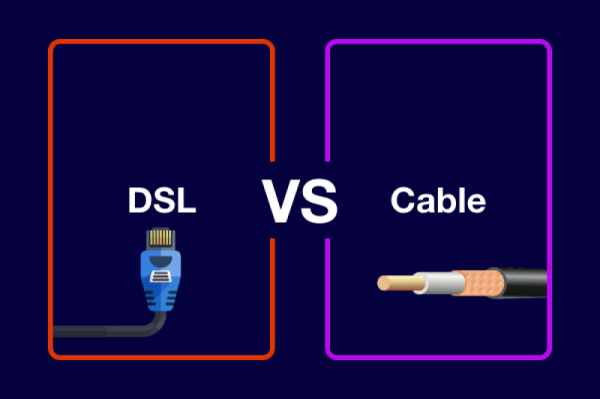Below is a comparison of DSL and cable internet, which are two widely available types of internet in the U.S. From speed to price to the cost of installation, you’ll find everything you need to know in this DSL vs. cable internet guide.
What’s the difference between DSL and cable internet?
Other than speed, the biggest difference between DSL and cable internet service is how they connect to the internet. DSL internet uses landlines to send data while cable internet uses coaxial cables.
Is DSL or cable internet faster?
Our pick for speed: cable internet
When it comes to speed, cable internet beats out DSL by a landslide. Typical speeds for DSL internet can range anywhere from around 1 Mbps to 50 Mbps, but they are usually on the slower side. According to the FCC, DSL internet can be considered high-speed internet if it has speeds that are at least 25 Mbps. However, the speed of your DSL connection will also depend on where you live. The further away you live from the provider’s location, the weaker and slower your signal will be; DSL signals don’t travel well over long distances. This means that even though your DSL provider might advertise download speeds of 25 Mbps, if you live too far away, you probably won’t be getting these speeds. Since you only need 5 Mbps to stream Netflix in high-definition, DSL is good enough for Netflix.
Cable internet providers typically offer faster speeds than DSL, ranging from 25 Mbps all the way up to 1,000 Mbps (aka 1 Gbps) thanks to new developments in cable internet technology. Unlike DSL, you won’t experience slower speeds with cable internet if you live further from the provider. However, with a cable connection your internet is delivered to your home through a central node that serves your entire neighborhood. This means that if several people on your street are trying to stream Netflix at the same time, you might experience slower speeds. This typically only happens during peak internet traffic times. Overall, cable internet offers faster and more reliable speeds than DSL internet.
Which connection is better for gaming: DSL or cable internet?
Our pick for gamers: cable internet
If you’re a big online gamer, we’d recommend going with a cable internet connection. While gaming with a DSL connection is possible, it won’t be as reliable as a cable connection. You’ll experience more latency and dropouts with DSL, especially if you live too far from the main internet source. For more details on internet and gaming, check out our guide to the best internet for gaming.
DSL vs. cable internet: which connection is more affordable?
Our pick for price: cable internet
Cable Internet | DSL Internet | |
|---|---|---|
Typical Plan Prices | $30 to $120 per month | $30 to $60 per month |
Average Download Speed | 25 Mbps to 1000 Mbps | 1 Mbps to 50 Mbps |
Nationwide Availability | 89% Coverage | 90% Coverage |
Data Limits | 50 GB to Unlimited | 50 GB to Unlimited |
If you’re simply looking for the cheapest internet plan available to you, DSL might be your best bet. Some DSL providers offer inexpensive starting plans. However, it’s important to keep in mind that these cheap starting packages typically have very slow speeds. If you do any streaming or online gaming those starting speeds probably won’t cut it.
Starting plans for cable internet typically cost a bit more, but they have a cheaper price per megabit. That means you’ll be getting a much better value for just a few more dollars every month. For instance, Xfinity’s starting cable internet plan offers download speeds up to 60 Mbps for just $29.99 a month. That’s plenty of speed for streaming, gaming, working from home or any other online activities.
How much do equipment and installation cost for DSL and cable internet?
Our pick for equipment and installation: it’s a tie between DSL and cable internet
The cost for equipment and installation with DSL and cable internet varies by provider. Typically, the only equipment you’ll need is a modem for DSL or cable internet. You can either buy or rent this equipment, depending on your provider. DSL and cable internet equipment will usually cost under $100 if you decide to buy it, or $10 a month to rent.
Some providers may require professional installation which can cost up to $100 on average. They will often waive the fee for installation when you buy certain bundles or during promotions. Keep an eye out for these deals so you can save on upfront costs! You might also be able to opt for inexpensive or free DIY installation, depending on your provider. Overall, it’s a tie for cost when it comes to DSL and cable internet installation and equipment.
Where are DSL and cable internet available?
Our pick for availability: it’s a tie between DSL and cable internet
DSL and cable internet are two of the most widely available types of internet in the country. Satellite internet is the only connection that has more coverage in the country. DSL has 89 percent nationwide coverage, while cable internet has 90 percent coverage, so they’re neck and neck. DSL and cable internet have less coverage in rural and remote areas.
The pros and cons of DSL and cable internet
Cable Internet | DSL Internet | |
|---|---|---|
Pros |
|
|
Cons |
|
|
Data caps for DSL and cable internet
Our pick for data caps: it’s a tie between DSL and cable internet
There are DSL and cable internet providers that impose data caps on their internet plans. This means that you’ll only get a certain amount of data to use each month. If you go over, you’ll have to pay data overage charges or your internet speeds will be throttled. The data caps will vary by internet provider, but many also have unlimited data options for a certain monthly charge. There are also DSL and cable internet providers that do not have data caps on any of their plans. Overall, DSL and cable tie for this category. The best way to find out which providers in your area have data limits is to use our search by zip code tool.
The verdict: DSL or cable internet?
Cable internet beats out DSL when it comes to speed and price. The two types of internet are tied when it comes to data caps, availability, and equipment/installation costs. Overall, we’d recommend cable internet. Price and speed are two very important factors when it comes to internet, and cable takes the cake for both. With download speeds up to 1,000 Mbps and a cheaper cost per megabit on most plans, cable internet is a more valuable option for anyone.
Use our search by address tool to find out which cable internet providers are available where you live.


